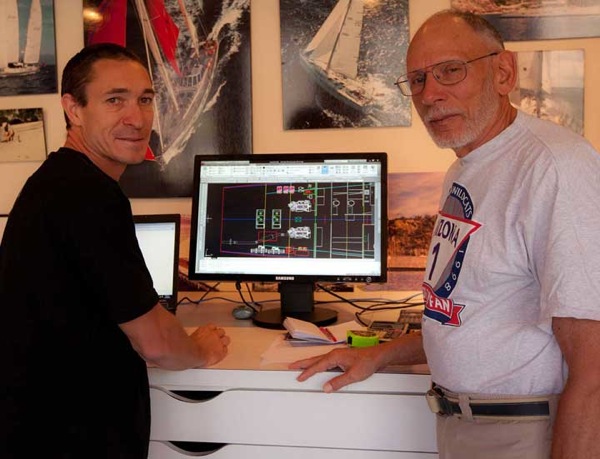
Ed Firth, one of Circa’s engineers, has been with us in Arizona the past week, refining the preliminary FPB 112 design. We thought a few comments on the process might be of interest.

Ed Firth, one of Circa’s engineers, has been with us in Arizona the past week, refining the preliminary FPB 112 design. We thought a few comments on the process might be of interest.
“Having lunch under way, we relaxed as the boat headed north at 11 knots…”
–Bill Parlatore, Passagemaker Magazine
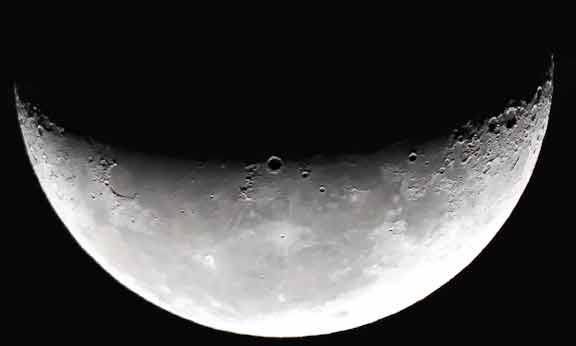
Speed often equals reduced motion when you have your design ducks in a proper row. But when you discuss this in polite circles (which for the purposes of this blog we shall include the local sailor’s bar)the concept often generates a hardly concealed look of disbelief. If you have ever ridden a bicycle slowly, wobbling this way and that, you will understand one of the principles which are at work. Or, if you have sailed high performance dinghies, and felt the stability that comes as you transition to a plane, you know whereof we speak.
That the combination of cruising, speed, and comfort is not more universally respected probably has to do with negative experiences brought on by excessive speed in an uncontrollable configuration. But if your autopilot can steer the boat as she accelerates,
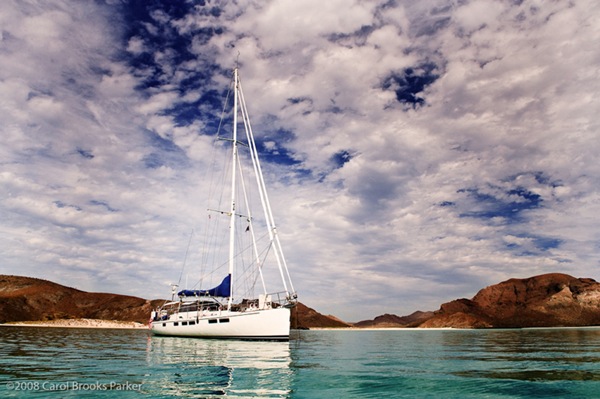
Carol Parker was kind enough to share some wonderful photos of the Sundeer 64, Raven, which she and husband Mike used to own. If you are stuck in depressing weather, waiting for spring, these will do a better job as an antidepressant than those little pills that are often prescribed. This first shot is near La Paz in Mexico’s Sea of Cortez.
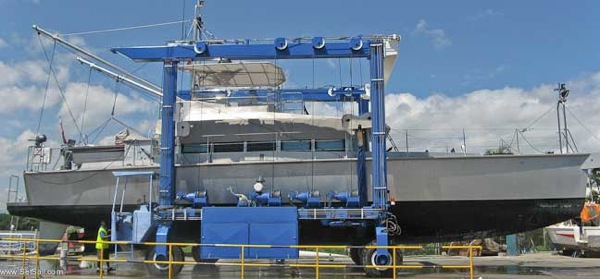
The various rules to which yachts are built are based on seagoing loads. If you design to ABS or Lloyd’s, odds are you will be OK offshore, but there is little extra margin for the mistakes which are a part of cruising. With an ABS keel structure, if you go aground, it is almost certain a trip to the boat yard is in your immediate future. But if you engineer to four times ABS, you are probably going to continue with your cruising.
We have tested these these theories ourselves, and had our owners repeatedly test them on our sailing designs. (Click here for a detailed post on our Black Swan theory of cruising.)Now we have some real world verification of the FPB 64’s factors of safety.
The photos which follow were taken of one of the FPB 64s after it tangled with a reef in the Fiji Islands. She has been hauled to replace a damaged stabilizer fin. At the end of this post is a link to the details of the event which has some excellent lessons for us all.
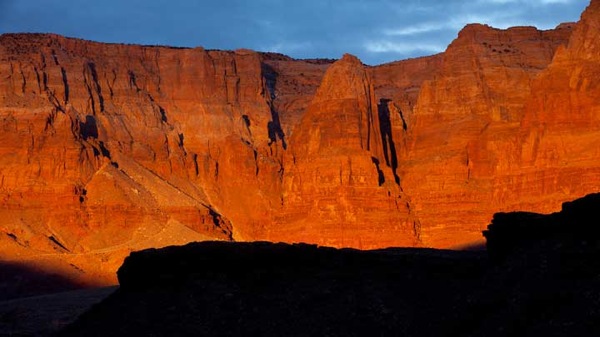
We have always believed that the best approach to life, and keeping the mind fresh, is diversity of experience. So with an intense period coming up on the FPB 112, and a trip to New Zealand for sea trials on two FPB 64s in the offing, we decided to sneak out of the office for a few days. The fact that master photographer Joe Zinn was available to show us some of his favorite spots in Northern Arizona made the choice of where to go easy.
[slidepress gallery=’northern-arizona-cruise’]
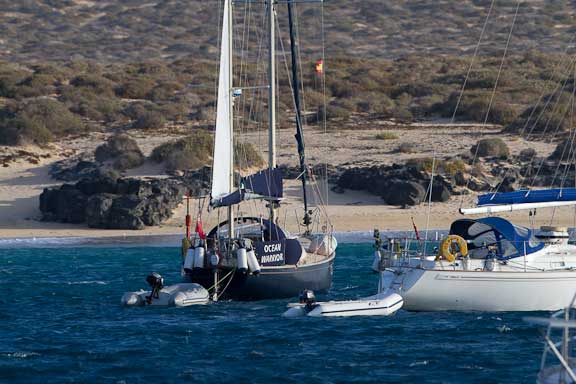
When the breeze starts to blow at anchor most yachts will shear – sail back and forth – at anchor. This can be uncomfortable, and substantially increases the load on ground tackle. The answer to this is a riding sail.
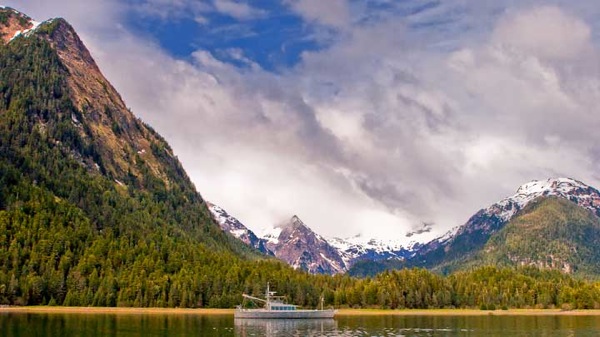
Prince William Sound, in southwest Alaska, is one of those places you just have to visit.
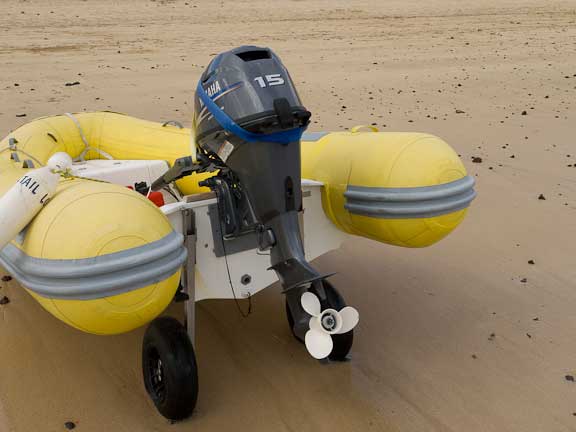
If you spend much time going to the beach with your dinghy you are going to want to consider a set of wheels. Eventually you will find that bigger wheels are always better.
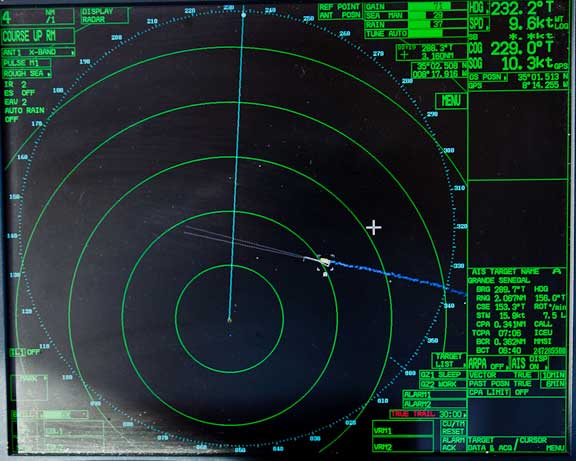
Modern radars have a wonderful ability to project the closest point of approach (CPA) between you and another vessel, and when (TCPA) this will occur. To do this the radar needs to know your speed and heading, and that of the target. Some times there is poor data in the loop in which case the CPA calcs are going to be off. In the photo above the radar is projecting the true course of the ship with the CPA information in the data box beside.
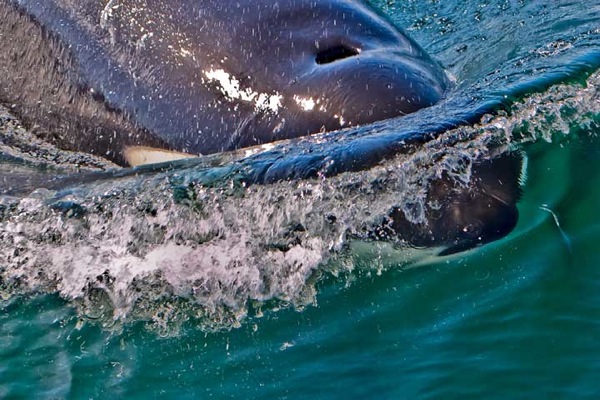
With photo collections and videos now somewhat more organized we have bandwidth to post a few more collections. We’ll start with Baja California and the Sea of Cortez.

While perusing the Cruising Club of America (CCA) website a few days ago we noticed an item on a partially completed book by Rod Stephens, he of Sparkman and Stephens fame (along with designer brother Olin). We knew, worked with on occasion, and immensely respected this wonderful seaman. Although our meetings and chats over the years were brief, we felt a connection (Rod’s book is available for download on the next page).
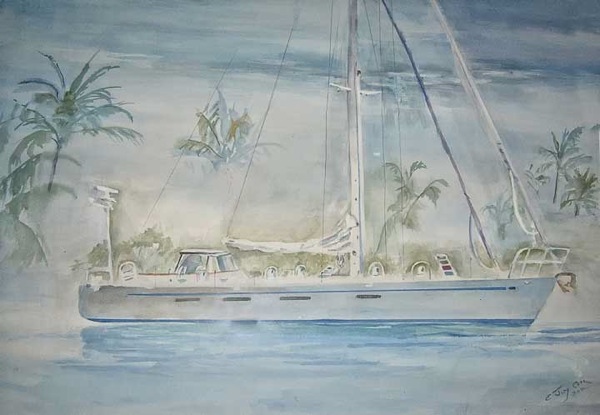
The watercolor above is of a Deerfoot 62. She is the second aluminum yacht we built and is a sistership to our own Intermezzo ll. Both were built in Capetown, South Africa. The photo was sent to us by Tim Gardner of Gardner Yacht Service, Orange Park, Florida. Tim’s comments follow.
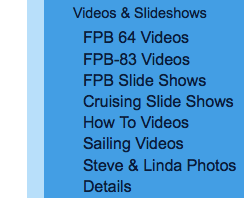
We have reorganized the videos and slide shows to make them more easily accessed. At present there are 47 of these to help pass the time.
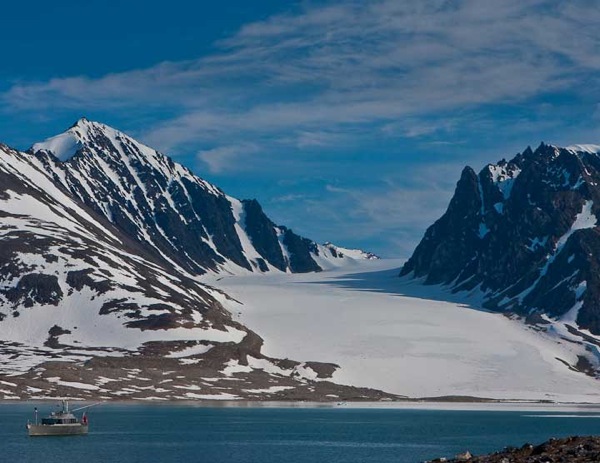
Recently someone commented to us on the amount of territory we cover with Wind Horse, and asked why we approach cruising in this manner.
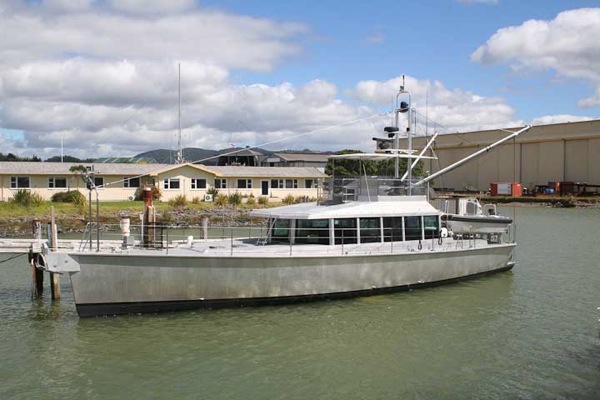
We have just received a few photos of Iron Lady which we thought might be of interest.
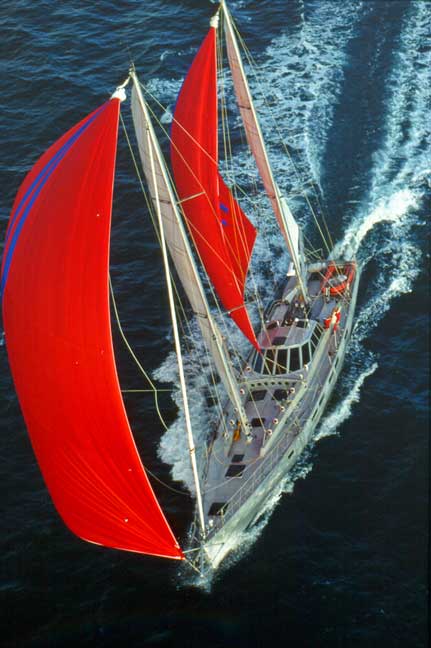
This past week we have been asked three times (by e-mail and in the marina) about the switch from sail to power, and what we thought about it now. Before answering the question some context is in order.
Prior to Wind Horse we had only twice set foot on a stinkpot, both experiences being very short. We loathed power boats, a feeling built up from years of negative interaction. Our sailing yachts, both racing cats in the olden days, and cruising designs more recently, were fast, nimble, and a joy to sail. Beowulf, the 78 foot ketch above and in subsequent photos, was the ultimate high performance cruiser, and crossing oceans aboard her was mostly a pleasure. We enjoyed sailing her agressively as a couple and the challenge of making quick, seamanlike passages, without undo risk, with just two of us aboard, was a big attraction.
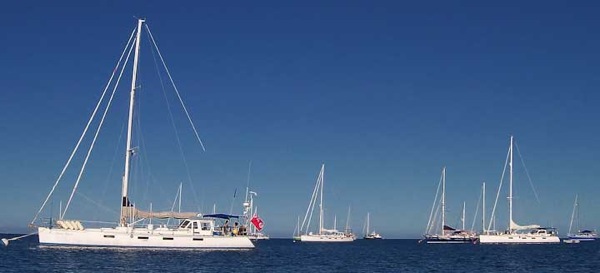
Gordon MacKenzie sent us this great photo of three Sundeers anchored in Musket Cove, Fiji.
Steve, what does an FPB64 measure out to for tonnage (USCG rules)?
Thanks
Rick de Castro
Hi Steve and Linda,
I need to install a watermaker on my Aerodyne 43 as a requirement for Transpac. I’d like a light and reliable unit, if there is one. Any recommendations? I’m willing to sacrifice output capability for light weight and reliability, if necessary.
Thanks,
Jeff Brauch
I am in the Philippines and need to get to NZ by years end. Has anybody made the trip? Which route did they use? ECC to Fiji, PNG or Aus east coast?
My boat is a 40ft cruising cat and neither it nor I like hard windward work.
Regards
Dave
“She’s meant to go places in comfort, and stay there for as long as her owners want.”
–Yachting Magazine
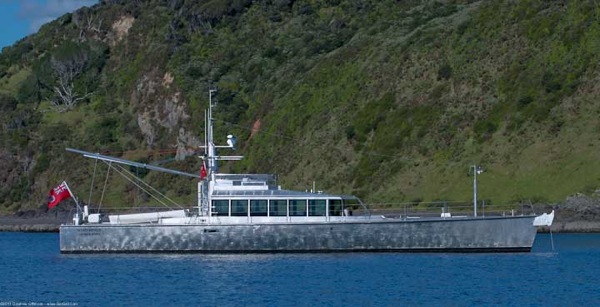
Last week, while driving with a friend through Colorado, Montana, and Wyoming, we were asked why our yachts look so different from the norm. That got us into a discussion about beauty, function, and environment (we’ll post some photos from that drive in a few days).
We have always believed that a yacht should make your heart sing, especially when viewed from the dinghy. And while some forms of art – yachts being included in this category – are an acquired taste, there are certain absolutes. Proportions, flow of lines, detailing commensurate with the overall design, are part of this equation. So to is how the object fits into its environment. Art on land is one thing. But when you take it to sea there are other issues. It is here that as Frank Lloyd Wright said “form follows function”. The more frequently one leaves the marina and the further one travels, the more absolute these seagoing considerations. Read the rest »
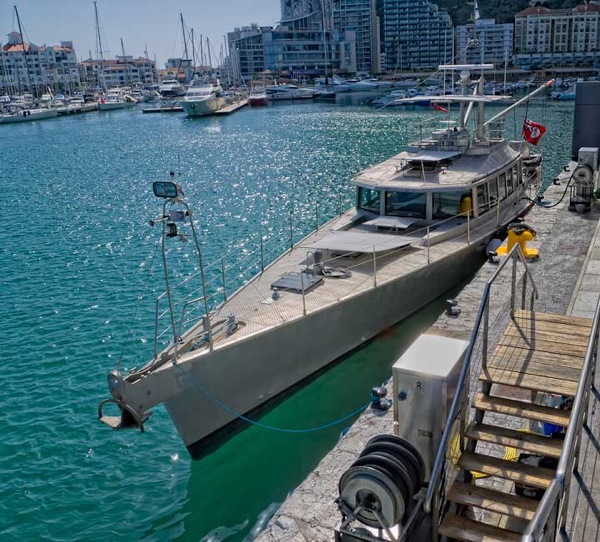 We get a lot of questions about range, fuel burn, boat speed, and how this works out in the real world. Whether you have an FPB or a trawler, the same basic issues apply. In this blog we are going to review the factors which impact the fuel equation and then compare data for several different types of vessels. The photo above and below of the FPB 83 Wind Horse, were taken in Gibraltar, a favorite (low cost) fuel stop. Read the rest »
We get a lot of questions about range, fuel burn, boat speed, and how this works out in the real world. Whether you have an FPB or a trawler, the same basic issues apply. In this blog we are going to review the factors which impact the fuel equation and then compare data for several different types of vessels. The photo above and below of the FPB 83 Wind Horse, were taken in Gibraltar, a favorite (low cost) fuel stop. Read the rest »

What’s wrong with this photo? Hint: the freeboard is touch low.
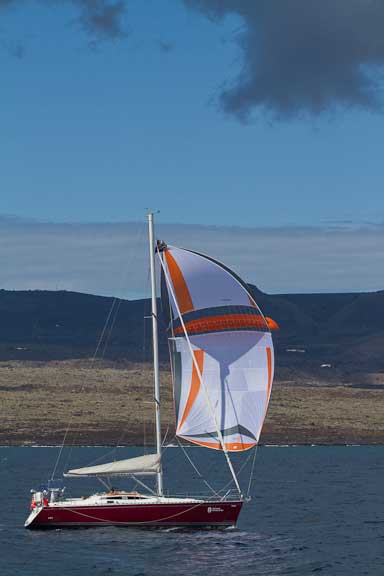
Some time ago we promised detailed photos of the stabilized spinnaker design which we shot in the Canary Islands. The concept is that the shuttered slots across the face of the sail reduce oscillation and improve stability. It is hard for us to judge the efficacy of the concept from a brief encounter, but it does look interesting.
“Low drag and hull efficiency mean that propulsion requirements for Wind Horse are miniscule – two 150HP diesels…The calculated range on full tanks is 6,000 nautical miles at 12 knots.”
–Sea Spray Magazine
 We get a lot of questions about range, fuel burn, boat speed, and how this works out in the real world. Whether you have an FPB or a trawler, the same basic issues apply. In this blog we are going to review the factors which impact the fuel equation and then compare data for several different types of vessels. The photo above and below of the FPB 83 Wind Horse, were taken in Gibraltar, a favorite (low cost) fuel stop. Read the rest »
We get a lot of questions about range, fuel burn, boat speed, and how this works out in the real world. Whether you have an FPB or a trawler, the same basic issues apply. In this blog we are going to review the factors which impact the fuel equation and then compare data for several different types of vessels. The photo above and below of the FPB 83 Wind Horse, were taken in Gibraltar, a favorite (low cost) fuel stop. Read the rest »

Every now and then we see something new which really works and is such an obvious answer that it is amazing it was not done previously.
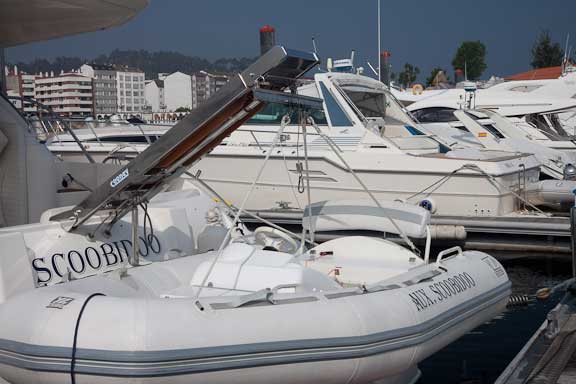
Here is an interesting use of the passeral we saw on a number of motor yachts. The dinghy in this photo will weigh close to 1000 pounds/450kg so there is substantial load with which the lifting mechanism must deal. It does make for a clean system.

If you have the dinghy rigged properly, and hanging over the side at anchor, single person launching is quite simple.

We have the complete set of data now from Circa on Iron Lady’s second set of runs. The data looks as expected for her displacement running in deep water and calm conditions (numbers are on the next page). She also appears to be a touch quieter, although without soft goods installed this is difficult to tell for sure.
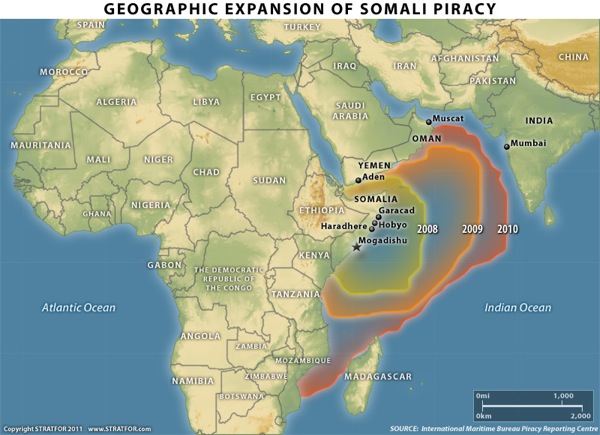
For most of us Somali piracy is a curiosity. But if you are crossing the Indian Ocean these days, even headed south towards South Africa, the risks are real. Stratfor is what we would call a private State Department or risk analysis outfit. Formed by George Friedman, they are considered the best in this business by the professionals. Their recently published report on Somali piracy
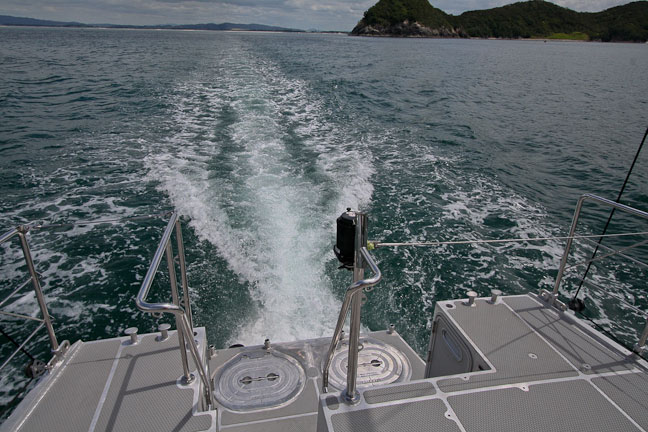
The second day of sea trials for Iron Lady has come and gone with unfortunately calm conditions. However, this is a chance to get deep water data and put some hours on the systems. She us running in these photos at 10.4 knots, turning 2000 RPM, with a pleasingly clean wake. There are a series of photos following, perhaps providing a degree of solace for Steeler fans.
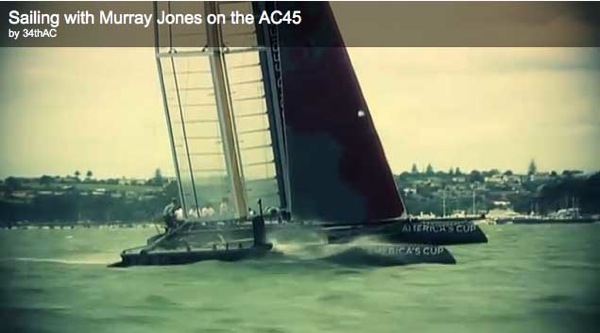
OK sports fans, today we have a glimpse into the future. For those of you opposed to the use of cats for the America’s Cup, or who are on the fence, take a look at the video we have for you. You will be astonished.
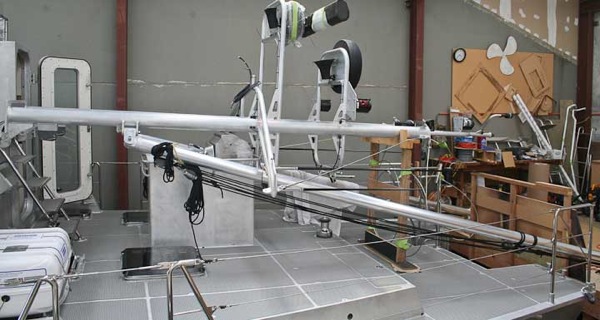
Over the last couple of years we have had numerous questions about the FPB 64’s hinged mast system. This is a costly exercise compared to a fixed rig.
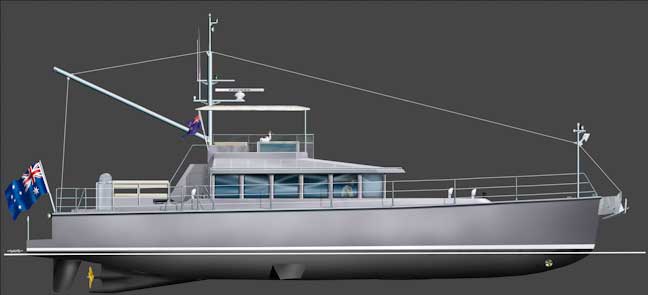
With the first run of FPB 64s nearing completion we have been at work on a few options for the next group of boats, most of which are retrofittable to the first run. We have also updated the drawings closer to the real world, the originals being somewhat out-of-date.
Let’s start with the back end of the boat.

Every fall there is a huge gathering of marine professionals at what is called IBEX. Every major vendor of marine items is there. Along with thousands of items to check out, there is an extensive array of hands on exhibitions and seminars. They have used photos of our designs in the past and this year the IBEX management created a poster featuring the FPB 64 Avatar. You can download a copy of

We hesitate to give out early performance information, but since the preliminary data off yesterday’s runs with Iron Lady are in the ballpark for what was expected, we thought we’d give you an early look. Iron Lady displaces roughly 34 metric tons / 75,000 pounds, in these early runs, as as she has a bit of fuel and water onboard. There were two runs, one up and one down tide, and these were averaged. Speed is from the GPS, fuel burn from the John Deere CPU display. Water is brackish and a touch shallow, both of which retard performance. The engine is a 235HP John Deere six cylinder diesel.
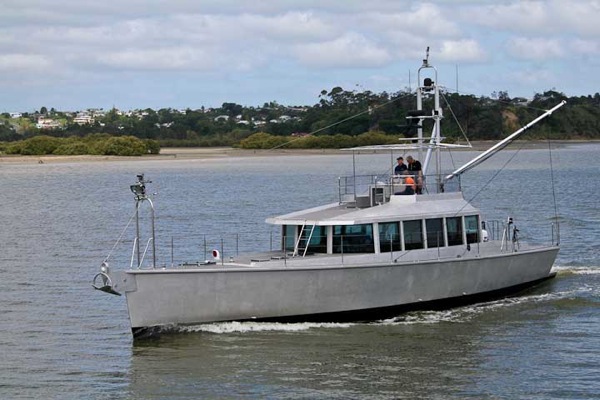
The basic dock check having been completed and stabilizers initialized,its time to see what she’ll do. The series of photos which follow have Iron Lady at about 34 metric tons / 75,000 pounds. She is doing approximately nine knots (instruments are yet to be zeroed in).
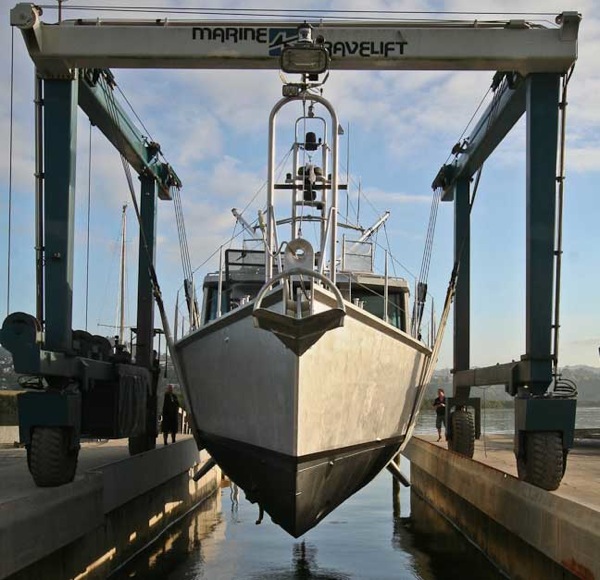
Let us introduce you to FPB 64-3, Iron Lady, about to start her sea trials.

Being cold and wet in much of the Northern Hemisphere, with long nights the norm, we thought some light reading material might be in order.

Anchor snubber lines, shock absorbers in reality, offer a number of benefits and several potential problems. Let’s address the rigging first.
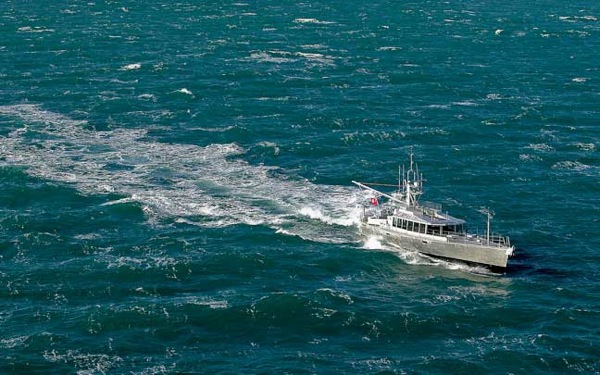
With 5200 hours on the engines, more than 50,000 mile in six cruising seasons, Wind Horse has proven to be our ultimate cruising tool. Now closing in on her seventh year afloat we have the proverbial wish list, with items big and small about which we need to decide. Considering that Wind Horse is being used far more intensively than any of our previous designs, and in much more demanding environments, our wish list is quite short.
When we are aboard, we are always thinking about fine tuning details, the curse of perfectionism with which we have lived these many years. But we have learned to wait before going forward, spend time ashore to give ourselves perspective, and then decide if it is really worth the time, effort, and expense to act on those desires.
This blog is a form of internal discipline. We want to recap how Wind Horse has been used, what is likely in the future, as part of the decision making process. Let’s start with where she has taken us. The distances, comfort level, conditions, and what we have learned.
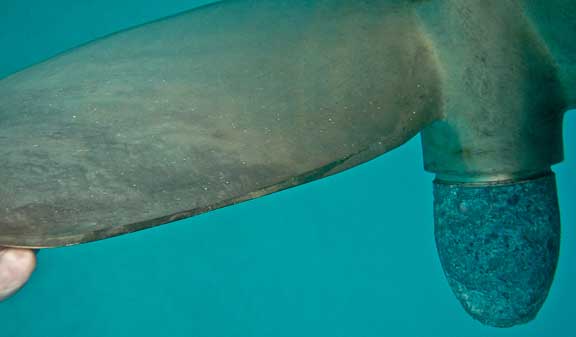
We usually specify what is called an anti-singing edge on our props. Essentially this is a chamfer on the forward face trailing edge of the blades as shown above. Occasionally this is not quite the right shape and at certain RPMs and loadings the prop will start a high pitched, and very annoying, song.
Pete Rossin, on of our FPB 64 owners, has researched protecting wireless Internet communications in the age of “Firesheep”. Pete has been kind enough to share the approach he has adopted, including screen shots, to make a similar installation relatively painless.
![]()
Mike and Carol Parker, the owners of the FPB 64 Avatar, are avid divers. We asked Mike for some details on how they handle getting three sets of dive gear into the dinghy, and Mike was kind enough to take a few photos and send some comments.
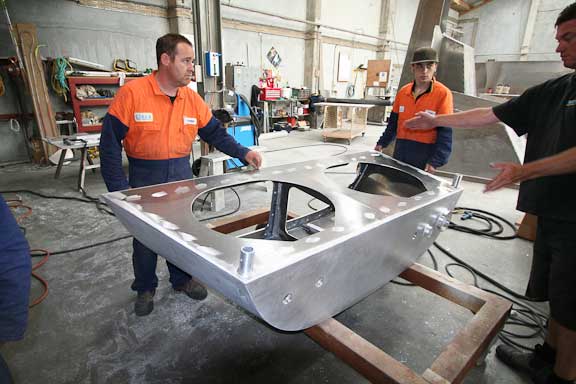
Within the next few days FPB 64 #3 will be ready to start sea trials. As she is being fitted with a swim step extension we are all awaiting the real world results from this small, but potentially potent addition.

We’ve finally figured out how to make some of our photos available as screen savers. There is a test collection now available.
Steve, Linda — Happy 2011 !!
There was a readers´ letter on this month’s Yachting World (btw, the same that brings your article – congrats!) mentioning that lightning strikes often seriously damage electric/electronic equipment on yachts … given that on the FPBs some basic functions are supported by electric/electronic stuff (fuel pumps, autopilot, etc), I was wondering whether you had to build some contingency for that? Moreover, are aluminum boats more prone to lightning strikes than their fiber/composite/wooden counterparts? Has Windhorse ever been stricken?
Best Regards,
Alex
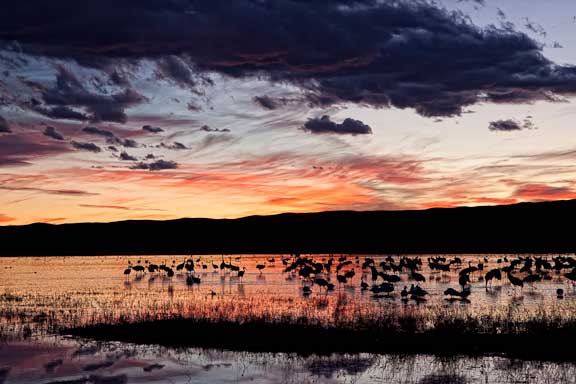
Since wings are a current topic in the marine world we thought this was a good segue to talk about Bosque del Apache.
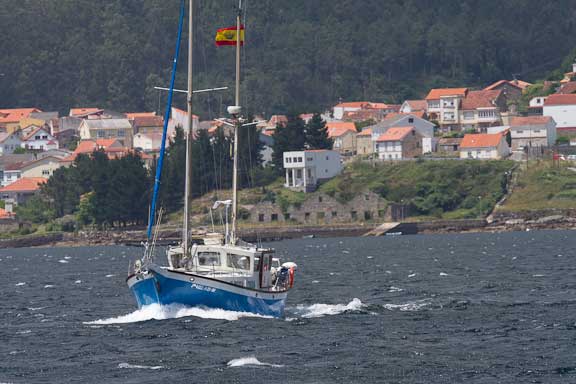
If you are going to cruise in cold climates a large pilot house is worth consideration
[slidepress gallery=’wh-favs-2′] Here is a high resolution collection of our favorite photos from the past five cruising seasons aboard Wind Horse. Join us in Read the rest »

There has been a ton of controversy about the format of the next America’s Cup, to take place in 72 foot wing-masted cats. Part of the package is a 45 foot “trainer” to get the crews up to speed on sailing with a wing.
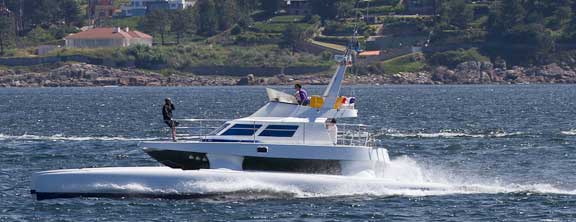
When we first started to think about doing an unsailboat for long distance cruising we briefly considered a power catamaran.

Sobering fact: you are going to be almost invisible to ships in any sort of breeze. A yacht is just too small to stand out in the waves and their white caps. Radar return, even with a radar reflector, is also hard to pick out of sea clutter. The one thing you can do is do paint the upper portion of the mast.
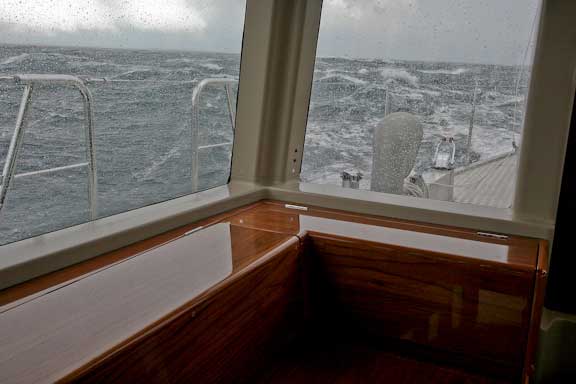
We’ve been aground in the office in Arizona for six weeks, enough time to get caught up and start thinking about next year’s testing afloat. All options are on the table. Returning to the US East Coast via Iceland and Greenland sounds intriguing, as does the South Pacific via the Canary Islands, Panama and the Galapagos. There is also the Med. option.
Lots of factors play into the decision. We are used to this of course. But what is surprising in this decision making cycle is the part which comfort at sea seems to be playing.
It didn’t used to be this way.
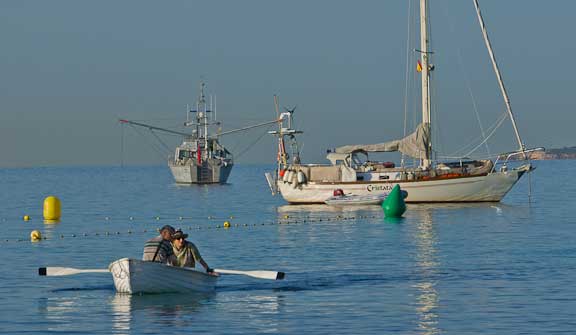
Most of the long term small boat cruisers we know prefer hard dinks to inflatables.
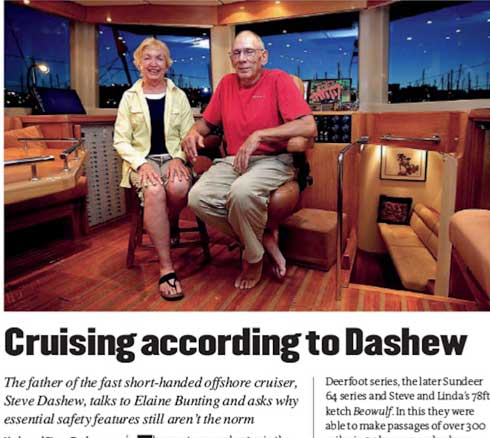
While we were in Las Palmas in the Canary Islands waiting for the ARC to start Wind Horse was the object of scrutiny by quite a few members of the European press. We had numerous journalists and photographers aboard, one of whom was
Hi Steve,
Happy New Year! I notice on Wind Horse you have used what appear to be PVC cowl / dorade vents.Do you find these superior to stainless steel, and if so, why? I am about to fit the dorade boxes to my alloy Dix43 and need to make the cowl selection. Thanks so very much.
Cheers
Brian
Have been admiring the FPB series on your website. Question: why do most of the Dashew boats carry 2 dinghies?
Best,
Bob Prins
None of the conventional approaches to get home systems in use today have the ingredients to meet our expectations. They all have shortcomings which we feel make them unacceptable. This led us to develop our get home sailing rig which in combination with a powerful dinghy tied alongside for close to harbor propulsion is a reasonable compromise.
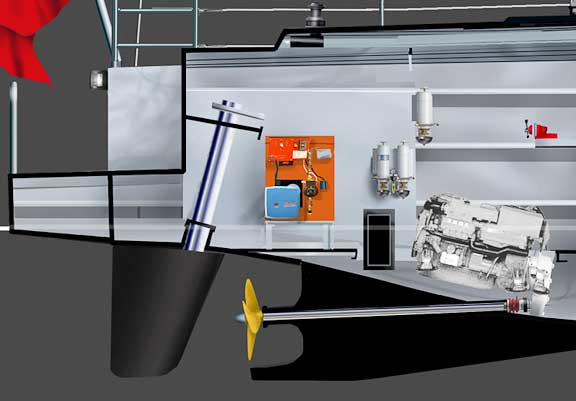
Now, with the swim step extension, there is another option which makes the FPB 64 get home system even better.
[slidepress gallery=’playa-francesa-favorite-photos’]

With 5200 hours on the engines, more than 50,000 mile in six cruising seasons, Wind Horse has proven to be our ultimate cruising tool. Now closing in on her seventh year afloat we have the proverbial wish list, with items big and small about which we need to decide. Considering that Wind Horse is being used far more intensively than any of our previous designs, and in much more demanding environments, our wish list is quite short.
When we are aboard, we are always thinking about fine tuning details, the curse of perfectionism with which we have lived these many years. But we have learned to wait before going forward, spend time ashore to give ourselves perspective, and then decide if it is really worth the time, effort, and expense to act on those desires.
This blog is a form of internal discipline. We want to recap how Wind Horse has been used, what is likely in the future, as part of the decision making process. Let’s start with where she has taken us. The distances, comfort level, conditions, and what we have learned.
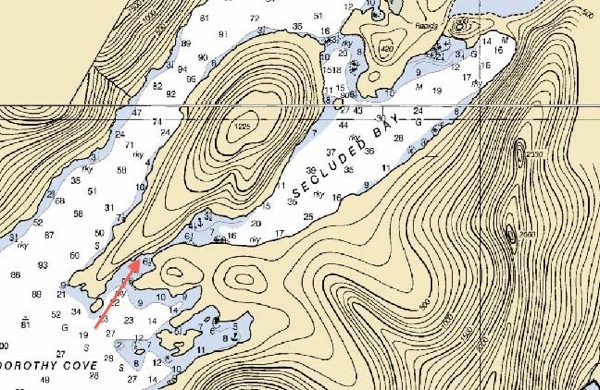 It is Saturday afternoon, football so far is boring, and having been on land now for almost a week we’ve been talking about some of our favorite anchorages. That lead to the thought that it might be nice to share a few of these with you. We’ll start with Secluded Bay, on the West Coast of Baranof Island, in Southeast Alaska. The arrow above points to the very narrow entrance. This was deep enough for the five toot (1.5m) draft on Wind Horse, but so narrow that the tree branches barely cleared our booms. Read the rest »
It is Saturday afternoon, football so far is boring, and having been on land now for almost a week we’ve been talking about some of our favorite anchorages. That lead to the thought that it might be nice to share a few of these with you. We’ll start with Secluded Bay, on the West Coast of Baranof Island, in Southeast Alaska. The arrow above points to the very narrow entrance. This was deep enough for the five toot (1.5m) draft on Wind Horse, but so narrow that the tree branches barely cleared our booms. Read the rest »
We recently created a hornets nest of comment here and elsewhere on the Internet when we mentioned what appeared to be a class B AIS filter on our IMO approved Furuno 2117 radar. Ben Ellison, who we consider the dean of marine tech writers, took us to task for spreading a false rumor. Ben has gotten so much conflicting comment that he went to one of the AIS tech mavens for the answer (you can read the final word on this subject here on Ben’s website). There are also a myriad of amateur and professional mariner comments, some of which are of interest.
There are many issues being addressed by commentators. We think most are missing the points which are critical to cruising yachts. To briefly summarize: